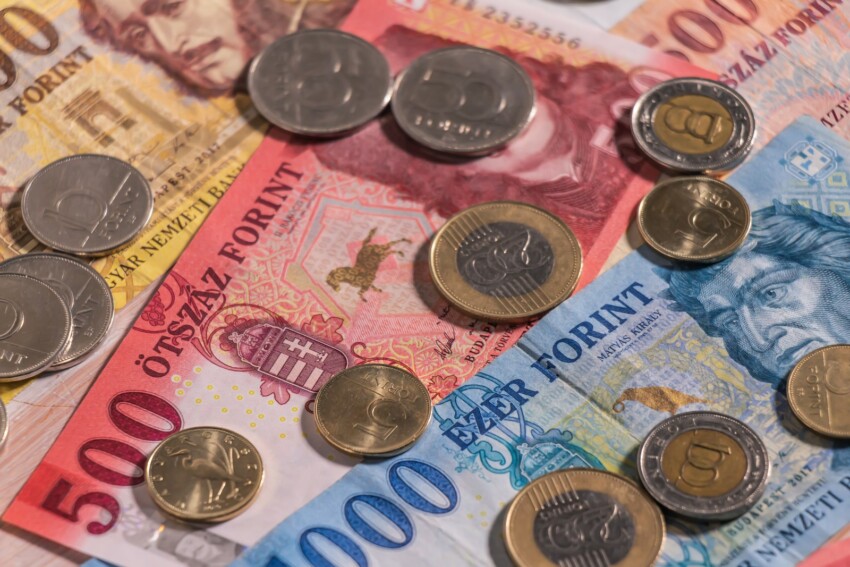

Hungary is one of the EU countries that has not yet adopted the Euro, so you will always have to pay in the local currency during your holiday in the Hungarian capital. The Hungarian currency is the Forint, indicated in exchange offices by HUF.
The exchange rate is always subject to change, but as a guide we can say that one Hungarian forint is worth about 0.003 euro, which is roughly equivalent to 300 forints for one euro.
Coins of 5, 10, 20, 50, 100 and 200 forints and banknotes of 500, 1000, 2000, 5000, 10000 and 20000 forints are available.
It is not easy to change euros into Hungarian forints while you are still in your country, but at Budapest airport and in the city centre you will find numerous exchange offices.
You may meet people on the street who offer to change money for you: always refuse, both because this practice is illegal and because the exchange rates charged by these crooks are always very disadvantageous.
A more practical and often much cheaper solution (depending on the conditions applied by your bank) than changing money in exchange offices is to withdraw money in local currency at ATMs.
ATMs in Budapest are easily found in all areas of the city and accept all popular international circuits. Your bank may charge a fee for cash withdrawals abroad: check this before you travel.
Credit cards are also commonly accepted in hotels, restaurants, shops and ticket offices of museums and attractions: if in doubt, ask if you can use your card before making purchases.
If you have not yet used an ATM or credit card outside Italy before you leave, make sure that your card is enabled for use abroad and ask about the maximum daily withdrawal amount.
If an ATM or credit card is lost or stolen, it is important to call your bank immediately and block the card. You will then need to file a report with the local police authorities.
The forint is the Hungarian currency. It is divided into 100 filler, even if those coins are no longer in use. The introduction of the forint dates back to 1946 and it represented a crucial step for the stabilization of the Hungarian economy after World War II. The currency remained relatively stable until 1980.
The word forint comes from the city of Florence, where golden coins were minted from 1252 and were called indeed fiorino d’oro. In Hungary, the gold-based currency Florentinus was used from 1325 under the reign of Charles Robert; after that, several other countries followed this example. Later on, between 1868 and 1892, the forint became the currency of the Austro-Hungarian Empire, known in the German language as Gulden or Florin.
The forint was reintroduced on August 1st 1946, after that pengő (the previous currency) became almost worthless by a massive hyperinflation that occurred in 1945–46.
In 1946 coins were introduced in denominations of 2, 10 and 20 fillers. The silver 5 forint coin was issued only in the following year before it was withdrawn from circulation.
In 1948 coins were introduced in denominations of 5 and 50 filler, while in 1967 was reintroduced the 5 forint coin, followed by a 10 forint coin in 1971 and by a 20 forint coin in 1982.
In 1946 notes in denominations of 10 and 100s were introduced by the Magyar Nemzeti Bank, that is to say the Hungarian National Bank. A new series of higher quality banknotes in the denomination of 10, 20 and 100 forint was introduced in 1947-1948. Moreover, 50, 500, 1000 and 5000 forint notes were introduced in the following years.
The forint was subdivided into 100 filler, which are similar to cents. Due to a new inflation that occurred during the 90s, they have no longer been in circulation. The forint was devaluated due to the transition to market economy. In 2000 this negative devaluation stopped and the forint was declared officially convertible.
In 1992 a new series of coins was introduced in denominations of 1, 2, 5, 10, 20, 50, 100 and 200 forint. The 200 forint coin was partly made of silver; however, it was withdrawn in 1998 because its nominal value was getting too low compared to the value of its precious metal content.
It was only in 2009 that a new 200 forint coin made of different metal was introduced.
A redesigned series of 200, 500, 1000, 2000, 5000, 10,000 and 20,000 forint was gradually introduced between 1997 and 2001. Each banknote was watermarked, containing an embedded vertical security strip which makes it suitable also for blind people.
Each banknote depicts a famous Hungarian prince, leader or politician on one side, and a place or an event related to that person on the opposite site. Such as:
City Card allow you to save on public transport and / or on the entrances to the main tourist attractions.
